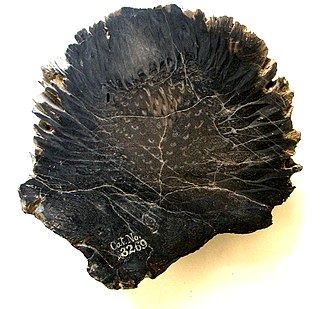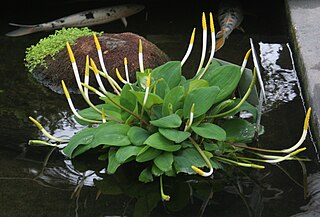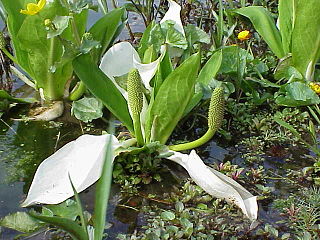
The Araceae are a family of monocotyledonous flowering plants in which flowers are borne on a type of inflorescence called a spadix. The spadix is usually accompanied by, and sometimes partially enclosed in, a spathe or leaf-like bract. Also known as the arum family, members are often colloquially known as aroids. This family of 114 genera and about 3750 known species is most diverse in the New World tropics, although also distributed in the Old World tropics and northern temperate regions.

The Marsileaceae are a small family of heterosporous aquatic and semi-aquatic ferns, though at first sight they do not physically resemble other ferns. The group is commonly known as the "pepperwort family" or as the "water-clover family" because the leaves of the genus Marsilea superficially resemble the leaves of a four-leaf clover. In all, the family contains 3 genera and 50 to 80 species with most of those belonging to Marsilea.

Pistia is a genus of aquatic plant in the arum family, Araceae. The single species it comprises, Pistia stratiotes, is often called water cabbage, water lettuce, Nile cabbage, or shellflower. Its native distribution is uncertain, but probably pantropical; it was first discovered from the Nile near Lake Victoria in Africa. It is now present, either naturally or through human introduction, in nearly all tropical and subtropical fresh waterways and considered an invasive species as well as a mosquito breeding habitat. The genus name is derived from the Greek word πιστός (pistos), meaning "water," and refers to the aquatic nature of the plants.

Bennettitales is an extinct order of seed plants that first appeared in the Permian period and became extinct in most areas toward the end of the Cretaceous, although some Bennettitales appear to have survived into Oligocene times in Tasmania and eastern Australia. Bennettitales are among the most common extinct Mesozoic seed plants, and had morphologies including shrub and cycad-like forms. The order comprises two families, the Cycadeoidaceae, represented by Cycadeoidea and Monanthesia, and the Williamsoniaceae including Williamsonia, Williamsoniella, Wielandella and Ischnophyton which had slender, branching trunks and either bisporangiate or monosporangiate strobili.
The Maastrichtian is, in the ICS geologic timescale, the latest age of the Late Cretaceous epoch or Upper Cretaceous series, the Cretaceous period or system, and of the Mesozoic era or erathem. It spanned the interval from 72.1 to 66 million years ago. The Maastrichtian was preceded by the Campanian and succeeded by the Danian.

Ampelosaurus is a titanosaurian sauropod dinosaur hailing from the Late Cretaceous Period of what is now France. Its type species is A. atacis, named by Le Loeuff in 1995. A possible unnamed species has given Ampelosaurus an age reaching to the latest Cretaceous, from about 70 to 66 million years ago.

Denversaurus is a genus of herbivorous nodosaurid ankylosaurian dinosaur from the Late Cretaceous of western North America. Although at one point treated as a junior synonym of Edmontonia by some taxonomists, current research indicates that it is a distinct nodosaurid genus.

Gargantuavis is an extinct genus of large, primitive bird containing the single species Gargantuavis philoinos. It is the only member of the monotypic family Gargantuaviidae. Its fossils were discovered in several formations dating to 73.5 and 71.5 million years ago in what is now northern Spain, southern France, and Romania. Gargantuavis is the largest known bird of the Mesozoic, a size ranging between the cassowary and the ostrich, and a mass of 140 kg (310 lb) like modern ostriches, exemplifying the extinction of non-avian dinosaurs was not a necessary condition for the emergence of giant terrestrial birds. It was once thought to be closely related to modern birds, but the 2019 discovery of a pelvis from what was Hateg Island shows several primitive features.

Axelrodichthys is an extinct genus of mawsoniid coelacanth from the Cretaceous of Africa, North and South America, and Europe. Several species are known, the remains of which were discovered in the Lower Cretaceous (Aptian-Albian) of Brazil, North Africa, and possibly Mexico, as well as in the Upper Cretaceous of Morocco (Cenomanian), Madagascar and France. The Axelrodichthys of the Lower Cretaceous frequented both brackish and coastal marine waters while the most recent species lived exclusively in fresh waters. The French specimens are the last known fresh water coelacanths. Most of the species of this genus reached 1 metre to 2 metres in length. Axelrodichthys was named in 1986 by John G. Maisey in honor of the American ichthyologist Herbert R. Axelrod.

Orontium aquaticum, sometimes called golden-club, floating arum, never-wets or tawkin, is a species of flowering plants in the family Araceae. It is the single living species in the genus Orontium, which also contains several extinct species described from fossils. O. aquaticum is endemic to the eastern United States and is found growing in ponds, streams, and shallow lakes. It prefers an acidic environment. The leaves are pointed and oval with a water repellent surface. The inflorescence is most notable for having an extremely small almost indistinguishable sheath surrounding the spadix. Very early in the flowering this green sheath withers away leaving only the spadix.
Paleopsephurus is an extinct genus of paddlefish in the Acipenseriformes family Polyodontidae. At present the genus contains the single species Paleopsephurus wilsoni.

Orontioideae is a subfamily of flowering plants in the family Araceae. The subfamily consists of three genera namely, Lysichiton, Orontium, and Symplocarpus. Characteristics of Orontioideae include medium sized pollen grains and subterranean stems. Species in the subfamily have a base chromosome number of X=13.
Banksia novae-zelandiae is an extinct species of Banksia, known only from fossil leaves found in the South Island of New Zealand.
Peltandra primaeva is an extinct species of monocot in the family Araceae known from a Ypresian age Eocene fossil found in western North Dakota, USA.

Orontium, sometimes called golden-club, is a genus of flowering plants in the family Araceae. The single living species in the genus is Orontium aquaticum, while the two other described species, Orontium mackii and Orontium wolfei, are known from fossils.

Orontium wolfei is an extinct golden-club species in the family Araceae described from a series of isolated fossil leaves. The species is known from Eocene sediments exposed in the state of Washington in the United States of America and the province of British Columbia in Canada. It is one of several extinct species placed in the living golden-club genus Orontium.
Hymenaea mexicana is an extinct legume species in the family Fabaceae described from a series of isolated fossil petals, leaflets, and amber. The species is known from a group of Late Oligocene to Early Miocene locations in southern Mexico. It is one of two extinct Hymenaea species placed close to the living species Hymenaea verrucosa and along with Hymenaea allendis, is one of the two extinct species which have been found in Mexican amber.
Stonebergia is an extinct genus in the rose family, Rosaceae, which contains the single species Stonebergia columbiana. The genus was described from a series of isolated fossil leaves in shale from an early Eocene location in southern British Columbia.
Sphaerium beckmani is an extinct species of fossil freshwater pea clams from the Late Cretaceous deposits of North America. This species was first described by the American paleontologist Loris Shano Russell in 1976. The specimens were collected by the American paleontologist Karl M. Waage from 1961 to 1962 from the Hell Creek Formation of eastern Montana. The locality is dated to the late Maastrichtian Age.

The Basturs Poble bonebed is a mega-bonebed of hadrosaur dinosaur fossils, discovered in Catalonia, Spain. Hundreds of hadrosaur fossils have been found at the site, which would have been on a large island during the Late Cretaceous when the animals preserved were alive. Despite the enormous amount of specimens, taxonomically informative material has been scarce at the site, leading to extensive debate as to its nature. The number of species present, age of the individuals present in the sample, and taxonomic identity of the remains have been the primary matters of debate. Previous considered to represent Koutalisaurus, Pararhabdodon, or multiple, perhaps dwarf species, it is currently thought that a single, indeterminate species of lambeosaurine was present at the site, and that individuals of many different ages were present.












